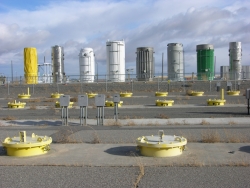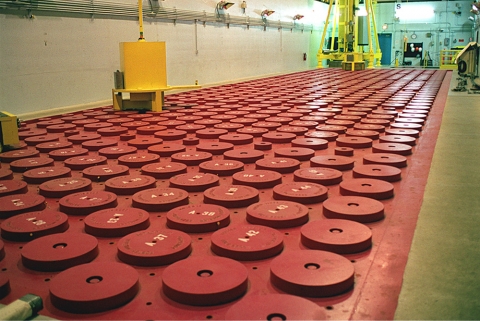
Dry storage casks at Idaho National Laboratory can safely house spent nuclear fuel for decades.
EM's mission is to safely and efficiently manage its spent nuclear fuel and prepare it for disposal in a geologic repository.
Previously, the Office of Environmental Management’s (EM) mission had included the safe and efficient management of its spent nuclear fuel (SNF) and preparation for its disposal in a geologic repository. However, in May 2009, the planned geologic repository at Yucca Mountain was cancelled. The Blue Ribbon Commission on America’s Nuclear Future (BRC) was formed by the Secretary of Energy at the request of the U.S. President to conduct a comprehensive review of policies for managing the back-end of the nuclear fuel cycle and recommend a new strategy. The January 2012 BRC report highlights the Commission’s findings and conclusions and presents recommendations for consideration by the White House Administration and Congress, as well as interested state, tribal and local governments, other stakeholders, and the public. These recommendations are still under review by DOE. Meanwhile, EM continues to safely and efficiently manage its SNF. EM works with stakeholders and Tribal governments and will help protect the environment and the health and safety of workers and the public by fully complying with applicable Federal, State, and local laws, orders, and regulations.
 |
|
Modular Vaults Dry Store (MVDS) is a dry storage system used at Idaho Engineering |
Through the National Environmental Policy Act, a decision was made in 1995 to consolidate DOE-owned SNF at existing DOE sites that have the skills, facilities and technologies to best handle the fuel. Based on the decisions from the associated environmental impact statement, DOE will temporarily store its SNF at the Hanford Site in Washington, the Idaho National Laboratory (INL) in Idaho, and the Savannah River Site (SRS) in South Carolina, until a repository is completed. The Hanford Site will retain most of its current inventory of SNF. The remaining DOE SNF will be consolidated at either the INL or SRS, depending on the type of fuel.
EM is currently managing approximately 2,400 metric tons of heavy metal (MTHM) of SNF at the three sites, including approximately 2,130 MTHM at Hanford; about 30 MTHM at SRS and about 275 MTHM at INL.
At INL, EM is planning to provide a SNF dry storage, packaging and load-out capability. This capability would provide dry storage capacity for all SNF at INL and the ability to prepare and package the fuel into a "road ready" condition as well as to enable DOE to meet the Idaho Settlement Agreement dates of having all SNF in dry storage by 2023 and out of Idaho by 2035. INL also receives and stores SNF from domestic and foreign test and research reactors.
At Hanford, a SNF project was formed specifically to address the urgent need to move SNF from degraded wet storage conditions in the 105 K East (KE) and the 105 K West (KW) Basins in the 100 K Area along the Columbia River Corridor. About 80% of the DOE’s remaining SNF was stored in the K Basins when the project began. The project completed fuel removal from deficient storage conditions in the K Basins in October 2004, thus decreasing risks to the public, workers, and the environment. The SNF was dried and placed in temporary storage in steel tubes below ground until a national geologic repository is available. At the completion of the SNF project, work to remove sludge, water and some of the debris from the K Basins was moved into a new project called the K Basins Closure (KBC) project. The KBC project also is responsible for encasing the K Basins (with some of their debris) in special concrete called grout, removing the basins, and burying them as waste.
In addition to the SNF in the K Basins, approximately 30 metric tons of non-defense production reactor SNF has been stored at various locations at the Hanford Site. The SNF project is consolidating most of this fuel in the Canister Storage Building/200 Area for safe interim storage.
SRS provides for the safe receipt and interim storage of SNF assemblies including SNF from domestic and foreign test and research reactors. Only L Basin still contains and receives SNF. The basins have concrete walls 3 feet thick and hold 3.5 million gallons of water with pool depths of 17 to 30 feet to provide shielding to protect workers from radiation.
